Why do building and fire codes require seismic design?
In earthquake-prone areas, building codes mandate special seismic construction for specific structural elements of buildings, like beams and supporting walls. The reasons for this are self-evident: we don’t want buildings to collapse during earthquakes, and their key components like beams and columns must be able to withstand the shaking.
Model building and fire codes also mandate seismic safeguards for nonstructural elements, however—systems and components within a building that perform core functions. Nonstructural elements include mechanical, electrical, plumbing, HVAC, and fire sprinkler systems.
The American Society of Civil Engineers (ASCE) is the leading authority in this area. Its model code, ASCE 7: Minimum Design Loads for Buildings and Other Structures, informs the International Building Code (IBC) and National Fire Protection Association (NFPA) documents about the protection of nonstructural elements. And the specific earthquake-protection applications in fire sprinkler systems are detailed in NFPA 13: Standard for the Installation of Fire Sprinkler Systems.
The failure of a fire sprinkler system after an earthquake means significant expense to get these systems back online and presents a serious risk to life safety. The latter is especially a concern, given the greater likelihood of fires after an earthquake.
QRFS can outfit you with some seismic design components, including flexible sprinkler drop assemblies and grooved flexible couplings that are available by special order. Simply call us at +1 (888) 361-6662 or email us at support@qrfs.com.
Historic quakes illustrate the expense and danger seismic events pose to fire protection systems
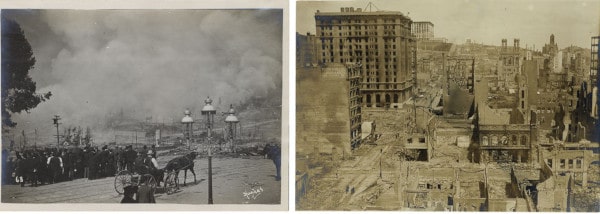
The financial impact of damaged fire protection systems during and after earthquakes
FM Global states that during the 1994 Northridge CA earthquake (a strong, magnitude-6.8 event), 74% of surveyed facilities “in areas of highest ground shaking … with inadequately braced sprinkler systems experienced sprinkler leakage or failure.”
Between the price of parts, labor expenses, and damage caused by flooding, repairing a fire sprinkler system and cleaning up the aftermath can be extremely costly. Depending on the extent of the damage and the type of the building, the expense of repairing all damaged nonstructural elements can sometimes exceed the value of the building itself.
Damaged fire sprinklers may also deprive owners of the use of the building. Even if it sustains no structural damage during an earthquake and the mechanical, plumbing, gas, and electrical systems remain functional, fire code may render a building with a damaged fire sprinkler system unfit for normal use. Building owners might be able to implement a fire watch to keep a business operational, but the manpower requirements can be costly.
Check out our previous blogs to understand the types and consequences of fire sprinkler impairments and to learn what goes into replacing damaged fire sprinkler heads.
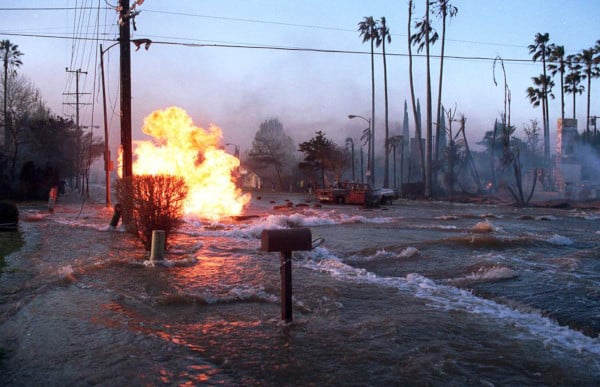
Fire risks after seismic events are elevated
Financial considerations aside, fire protection systems are especially crucial during and after earthquakes. As the NFPA Journal explains, fires may become more frequent due to exposed wiring, arcing electricity, gas leaks, and other fuel spills that create an elevated fire risk.
After the Northridge CA earthquake, there were over 14,000 natural gas leaks and 110 fires, according to FM Global. The 1906 San Francisco earthquake, one of the worst natural disasters in US history, ignited fires that burned for three days and destroyed almost 500 city blocks. It is doubly important that at-risk fire protection systems have the seismic protections that enable them to work as intended.
Where is seismic design needed? And how much seismic support for pipes is required?
Earthquakes don’t happen everywhere, of course, and not all earthquakes are the same. There’s no need to design buildings that will never experience earthquakes to the same standard as a skyscraper built near a fault line. So, which buildings need seismic protection, and how much? In a nutshell:
- Each building is assigned a seismic design category (SDC), which accounts for the likely severity of an earthquake and the danger it poses to human life.
- SDCs range from A to F, with F being the most severe.
- Local authorities and local laws determine how fire sprinkler systems should be protected against earthquakes—based largely on these SDCs.
The ASCE is the authority in determining the seismic design category (SDC) of a building and the components within it. NFPA and the IBC both follow the lead of the ASCE and its ASCE 7 model code, and authorities having jurisdiction (AHJs) commonly use ASCE 7 to determine when and how much seismic protection is necessary for nonstructural elements. NFPA 13 does not determine when seismic protection is necessary for fire sprinklers—it merely says how seismic protection should be implemented.
ASCE 7 uses two sources of information to determine a seismic design category (SDC): occupancy category and the level of seismic risk, often determined by seismic hazard maps from the U.S. Geological Survey (USGS).
The occupancy category of a building is determined using criteria described in Chapter 1 of ASCE 7. Occupancy categories describe, in ascending order from I to IV, the risk to human life posed by the failure of the structure in question. Category I structures are usually or always unoccupied, whereas Category IV buildings include hospitals, police and fire stations, emergency shelters, and facilities storing extremely hazardous materials. The higher the occupancy category, the stricter the seismic design requirements.
Seismic hazard maps published by the USGS provide information about the likelihood and strength of earthquakes. These maps display information such as the peak acceleration of potential earthquakes with the probabilities of its exceedance over certain periods. This information, in combination with the occupancy category, informs the determination of the seismic design category, which ranges from A to F.
Category A has the least earthquake concern. Category F, which requires the strictest seismic protection, is reserved for Occupancy Category IV buildings near major active faults. Note that information such as a potential earthquake’s period acceleration that is provided by seismic hazard maps is also necessary to perform calculations required by NFPA 13.
You should not have to navigate ASCE code or read USGS maps to determine your building’s seismic design category or obtain the calculations required by NFPA 13, however. Relevant information like SDC and expected acceleration values should be listed in the structural notes of the building’s plans.
As for determining when seismic design measures for fire sprinkler systems are necessary, the local authority having jurisdiction has the final say. Recommended Seismic Provisions for New Buildings and Other Structures, a publication of FEMA’s National Earthquake Hazard Reduction Program (NEHRP), offers some guidance. For seismic design category C, it says that “critical nonstructural components must be provided with seismic restraint.” For categories D through F, stricter recommendations are made, including that life safety components be able to function after an earthquake.
How seismic design prevents earthquake damage
Seismic design techniques protect nonstructural elements during an earthquake by countering various kinds of motion that cause damage. Understanding how earthquakes move the ground (and buildings) reveals why different seismic design measures are necessary. But, in short:
- Two types of waves—P-waves and S-waves—follow in the wake of an earthquake, causing shaking, bending, and twisting.
- Flexible components reduce stress during a seismic event by allowing sprinkler systems to move or bend at specific locations. Seismic bracing restrains the movement of pipes and fittings to prevent collisions with walls, ceilings, and other parts of the building.
The remainder of this article examines the techniques and technologies used to increase the flexibility of fire sprinkler systems. Our article on seismic design for fire sprinklers further details seismic bracing technology. And our article on NFPA 13 seismic bracing requirements detailed look at the code requirements and installation techniques involved in seismic bracing.
A mix of rigidity and flexibility best protects sprinkler systems against earthquake damage
Earthquakes are caused by sudden slips of the earth’s crust. When this movement occurs, waves travel through the earth. Earthquakes produce two kinds of waves: P-waves and S-waves.
P-waves, or primary waves, are like sound waves in that they are compressional. As they move through the ground, they alternately compress and expand the particles in the soil. P-waves are generally the faster of the two wave types. Because they cause relatively little motion in the earth’s surface, P-waves tend to cause far less damage.
S-waves, or secondary waves, cause the majority of earthquake damage. They move through the ground like ocean waves move through water, displacing rather than compressing the particles. S-waves move the earth—and buildings on it—in three dimensions: up and down, side to side, and front to back.
Seismic design measures account for varying secondary waves. The International Risk Management Institute identifies two core ways that earthquakes damage nonstructural elements: inertial effects (i.e. shaking) and distortions (i.e. bending and twisting) from differential movement.
Seismic design for nonstructural elements—including fire sprinkler systems—protects against inertial effects and distortions in two ways:
- Built-in flexibility minimizes the stress put on fire sprinkler systems by the differential movement of structural elements.
- Additional bracing and restraints connect sprinkler systems to structures so they will move as a unit, reducing shake damage.
The remainder of this article examines the techniques and technologies used to increase the flexibility of fire sprinkler systems.
Seismic support for pipes: Flexibility and clearance protect from differential movement in non-structural elements
Buildings move in three dimensions during an earthquake, but not all of a building’s components move as a unit. Different structural elements—such as foundations, beams, and columns—can move in different directions and speeds at different times. Separate wings of a building, as well as adjacent buildings with shared utilities, also may not move together.
This phenomenon is referred to as differential movement. It damages fire sprinkler systems by applying torque, causing pipes to slam into structural elements, and spurring pipe separation.
One cause of differential movement is story displacement. Story displacement occurs when a level of a building moves horizontally relative to the ground. Recall that S-waves displace the ground—and the foundations—laterally. But (if you recall your physics lessons on inertia) the vertical structure of the building does not immediately move side-to-side with the ground. It lags behind, causing the building to sway.
Thus, nonstructural elements like fire sprinkler risers that run vertically through a building can sustain damage from the differential movement of story displacement.
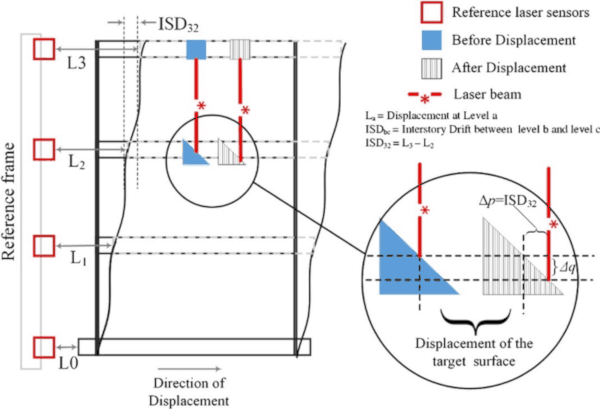
Another source of damage to fire sprinkler systems is the differential movement of independent structures.
Utilities often cross gaps between buildings or between different wings of a single building. These gaps may be incidental, or they may have been designed to protect structures from seismic events (in which case they may be referred to as seismic joints or seismic gaps).
In either case, the buildings or wings on either side of a gap can be expected to move differentially during an earthquake. As FEMA explains, earthquake damage to nonstructural components at seismic gaps is very common. With each structure moving independently in three dimensions, fire sprinkler pipe crossing such a gap can be pulled apart, crushed, slammed against adjacent structural members, or snapped.
Wide clearance prevents fire sprinkler pipe from slamming into structural members
Seismic clearance requirements vary with pipe size
Piping often must pass through elements like beams, ceilings, floors, and walls. Where it is not expected to move as a unit with the element it passes through, section 18.4 of the 2019 edition of NFPA 13 requires sufficient clearance around the piping to prevent slamming during differential movement.
Section 18.4.2 details the size requirements for clearance holes, specifying that:
- 2 inches (nominal) clearance must be provided around pipe with a nominal diameter between 1- and 3.5-inches diameter.
- 4 inches (nominal) clearance must be provided around pipe with a nominal diameter of 4 inches or larger.
Section 18.4.3 explains that the clearance provided by a pipe sleeve should use these same dimensions.
Depending on the pipe’s type or the construction of neighboring materials, larger holes may not be required
Clearance is not required where pipe passes through structural members in certain instances, however, including:
- When pipe passes through easily breakable materials like gypsum board (4.4)
- When flexible couplings are installed on both sides of the wall or beam within 12 inches of the surface (4.5)
- When certain conditions for short riser pipe are met (4.5)
- When pipe passes perpendicularly through studs or joists that form a single wall or floor/ceiling (4.6)
- When using nonmetallic pipes that have equal or greater flexibility than any flexible couplings that are installed on either side of the structural service (4.7)
Additional requirements help to guarantee the right amount of free space
It’s important to work with fire safety and engineering professionals to ensure that sufficient clearance is allowed where pipe passes through structural members. And the creation of clearance must not compromise the integrity of the structural member.
In addition, as section 18.4.8 of NFPA 13 indicates, building code may require pipe penetrations to be sealed with flexible, fire-stopping material.
Also note that, per 18.4.11, sprinkler heads need to be at least 3 inches clear of structural members (excluding those that support the sprinklers). This requirement can make installing sprinklers in ceilings difficult, but the problem can be solved by using flexible fire sprinkler drops rather than rigid armovers.
Flexible couplings reduce damage from differential movement
Controlled flexing can prevent harm to and provide seismic support for pipes
Flexible pipe couplings reduce the strain on pipes during an earthquake by allowing them to bend and flex with the structure. NFPA 13 defines a flexible coupling as follows:
3.3.78 Flexible Coupling. A listed coupling or fitting that allows axial displacement, rotation, and at least 1 degree of angular movement of the pipe without inducing harm on the pipe. For pipe diameters of 8 in. (200 mm) and larger, the angular movement is permitted to be less than 1 degree but not less than 0.5 degrees.
Flexible grooved pipe couplings work on the same basic principle as rigid grooved couplings—a C-shaped gasket secured by a housing creates a seal where two pipes meet. But flexible couplings, unlike their rigid counterparts, are designed to maintain their seal despite some axial separation and angular deflection of the pipe ends. They also permit axial rotation, sometimes by as much as 360 degrees.
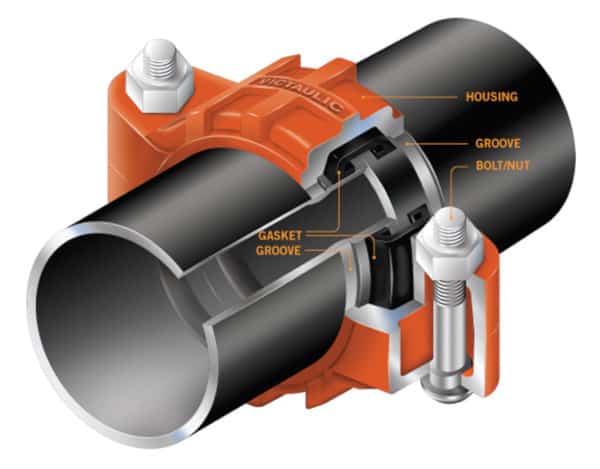
Grooved pipes at or over 2 1/2” in diameter, including those found at many fire sprinkler risers, may require flexible couplings
A fire protection professional must select couplings that fit the fire sprinkler pipes and provide enough flexibility for a building’s specific seismic conditions. Flexible couplings for grooved pipes will vary based on:
- Pipe diameter
- Maximum pressure rating
- Maximum pipe separation (typically increasing with diameter)
- Maximum angular deflection (typically decreasing with diameter)
- Maximum end load
These couplings mitigate stress from differential movement by allowing the pipes to flex with the building, moving “differentially with the individual sections of the building to which [they are] attached.” (NFPA 13: 18.2.1). As NICET IV Certified Senior Engineering Technician Steven Scandaliato explained in a presentation for the Center for Life Safety Education, flexible couplings “shall be arranged to coincide with structural separations within a building.”
Section 18.2.1 of NFPA 13 specifically requires that piping 2.5 inches and larger with grooved ends shall use flexible couplings in certain installation scenarios identified in section 18.2.3.1. This means that the fire sprinkler risers, which are particularly vulnerable to story displacement, need flexible couplings.
Section 18.2.3.1 specifies that flexible couplings shall be installed on risers in the following locations:
- Within 24 inches of the top and bottom of each riser, with some exceptions for short risers
- Within 12 inches above the floor in multistory buildings, with exceptions for roofs
- Within 24 inches below the floor in multistory buildings
- Within 12 inches of the surface of concrete or masonry walls, with exceptions made where adequate clearance is provided
- Within 24 inches of building expansion joints.
Besides these riser locations, NFPA 13 requires flexible pipe couplings at horizontal tie-ins to the riser (18.2.3.2) and for drop pipes (18.2.4).
Seismic separation assemblies provide multi-directional flexibility at building gaps
Where horizontal fire sprinkler pipe crosses gaps or joints of building structures, it can sustain serious damage in an earthquake due to the differential movement of the buildings. For this reason, it may be better to build each wing of a building with its own riser.
Where this is not possible, an approved seismic separation assembly, sometimes called a seismic swing joint, is necessary to provide sufficient flexibility at building joints.
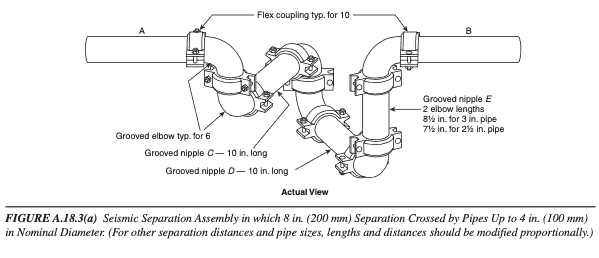
One type of seismic separation assembly arranges flexible couplings in a series with elbow bends to combine their ability to rotate and sustain angular deflection. Such an assembly protects piping that crosses a gap between structures when the structures move vertically, longitudinally, or laterally relative to the path of the pipes.
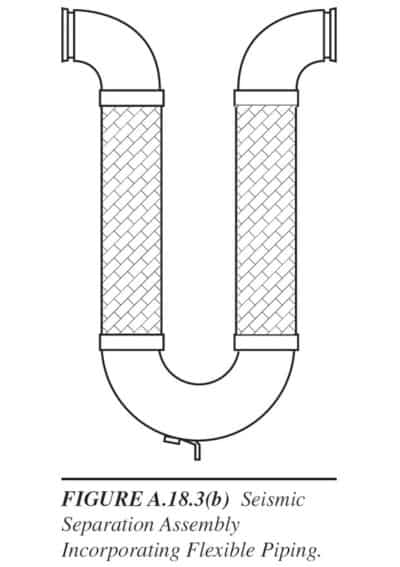
Section 18.3.1 of NFPA 13 states: “An approved seismic separation assembly shall be installed where sprinkler piping, regardless of size, crosses building seismic separation joints at ground level or above.”
The NFPA 13 Handbook (A.18.3) explains that the amount of movement allowed by the separation assembly should “accommodate calculated differential motions during earthquakes” or be twice the distance separating the buildings.
Flexibility is just one of the seismic design methods for protecting fire sprinkler systems
Earthquakes can cause serious damage to nonstructural equipment like fire sprinkler systems, leading to significant financial losses and life safety concerns. NFPA 13—informed by the ASCE—provides detailed, fairly strict requirements for the protection of fire sprinkler systems from seismic events.
During earthquakes, the ground (and the buildings on it) move in three dimensions, and nonstructural components such as sprinkler systems can sustain damage from differential movement and shaking. Installing flexible pipe couplings, leaving clearance around pipes, and using seismic separation assemblies at building joints provide sprinkler pipe the flexibility needed to avoid failure.
But NFPA 13 also describes another seismic protection for fire sprinkler systems: seismic bracing and restraint, whereby the firm attachment of pipe to structural members keeps the pipe from getting damaged. Read our article Seismic Design for Fire Sprinklers, which explains the principles and technologies behind seismic bracing.
We carry flexible sprinkler drop assemblies to give your system the flex it needs in all the right places—and grooved flexible couplings are available by special order. Simply call us at +1 (888) 361-6662 or email us at support@qrfs.com.
This blog was originally posted at blog.qrfs.com. Check us out at Facebook.com/QuickResponseFireSupply or on Twitter @QuickResponseFS.


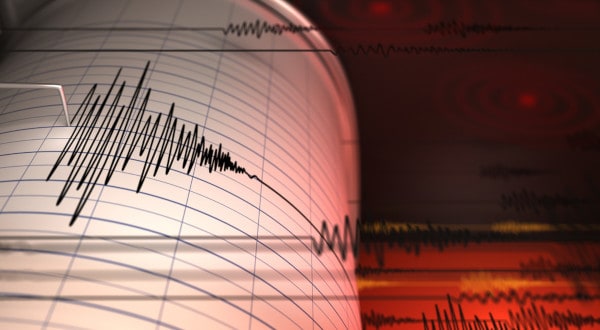
Buna,
Aceste sisteme flexibile pentru preluarea deplasarilor in caz de cutremur sunt disponibile si pentru conductele de abur?
Multumesc,
Calin
Calin — There are seismic design principles and components for all key nonstructural elements of buildings, including steam pipes. And we’d suspect that they use similar and sometimes the same seismic equipment. But we cannot comment beyond this equipment’s application in seismic design for fire protection, as that is all that we know well.
You might contact the manufacturer directly, such as Loos for seismic cables, to discuss the accepted applications: https://www.loosseismicbracing.com/ Best of luck!
Hello I am interested in finding out everything I need to do to get a seismic certification to operate a seismic installation company ie(sub contracting)out to fire protection company’s I’m have a 30 years in Fire Protection .I feel that it would be a very important key component to the industry . I have been questioning companies about this possibility but not gotten any straight answers concerning the licensing to be able to involve a sub to handle there seismic needs .Is there any national or state certifications. Needed.
Everything that ur able to steer me in the proper direction with would be a great help.
Gregory Steele
Gregory — Regarding education, there are various options such as programs/certifications for engineers (if applicable) from educational institutions, and fire-protection-specific programs at organizations like Fire Smarts and the National Fire Sprinkler Association NFSA.
Regarding federal or state government certifications, our answer is “unsure” and it “depends on the state.” For example, we know CA has comparatively stringent requirements for doing any fire protection work, and it might have additional requirements for seismic (or not), given the earthquake risk. So, for example, if you are in CA, a good step is to contact California’s State Fire Marshal and Contractor’s State License Board to ask about requirements. Obviously, if you are in another state, it’s relevant to contact their relevant boards/AHJs.
In addition, the trainers mentioned above (NFSA and Fire Smarts) should be a good resource. We hope this was helpful and best of luck!